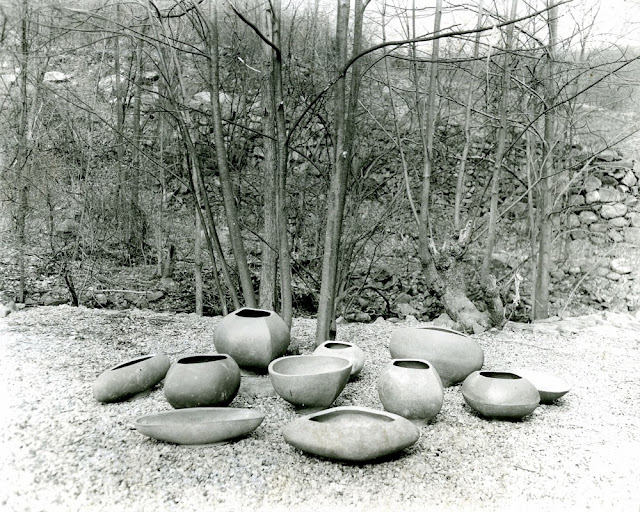Chris Gustin
South Dartmouth, MA
Words on potter Chris Gustin from Art School Blog guest writer and potter Bruce Dehnert:

If you’ve ever visited the Watts Towers tucked-away somewhere in the
urban caverns of Los Angeles you’ll recall marveling at the histories that are
literally embedded in their concrete skins. One slice of history you might not
know is that some of those multi-hued ceramic tiles, broken into thousands of
shards, originated from a factory owned by Chris Gustin’s family. Located in
Pasadena, the factory produced a range of wares that the family sold through
showrooms from San Francisco to Atlanta . When Chris was only 20 years old the
job of running the Los Angeles factory was thrust upon him when a long-time
floor boss died. So there he was, surrounded by clay, glazes, and kilns and having
to organize workers around the challenges of making things work, without a
hitch, through a rather sudden transition. It was this factory’s rejected tiles
that Simon Rodia used for his fanciful mosaics covering the beloved and
controversial ‘towerland.’ Today, the Watts Towers rise above the city streets
as a National Historic Landmark.
A
reclusive day laborer, Rodia would quietly disappear from southern California
in 1955, a victim of complaints and gossip.
Nearly fifteen years later, Chris found his way to the Kansas City Art
Institute to pursue his BFA in studio ceramics.
In 1975, Chris entered the MFA program at Alfred University. While
there he studied under the storied faculty members Randall, Turner, Cushing,
Hepburn and Higby. In those days art festivals were few and far between but
were catching on especially along the East Coast. During his second year at
Alfred, Chris attended one such show at Spring Valley where he met Karen Karnes
and was immediately drawn to her fiery character and the seriousness with which
she approached her work and the business around it. The Vermont potter’s
approach was inspirational to Gustin as he began to make plans for life after
school.

With his MFA in hand, Gustin moved to Guilford, Connecticut and opened
his first professional studio.
Shortly
afterwards, he remembers the phone call from Karen with an invitation to
exhibit in the Old Church Pottery Show as being one of the most important of
his career. After all, the Pottery Show was much more than just a few days of
harried sales. The event was a chance to get together with other potters and
their ilk, to get out of the hovels of studios and have real exchanges with
others who shared the struggle or an appreciation for handmade pots. Gustin
recently observed, “Mikhail Zakin, Karen’s co-organizer, was very supportive at
a time when I was just trying to ‘get my legs’ in the field. Being a part of
that group was a big deal. I mean, this was the late seventies and early eighties…there
were no Garth Clark type of galleries then and everyone was trying to find some
ground. It was transformative.” It was also in that same year of his first
appearance at Old Church that Chris’ work was selected for
The Young Americans, the monumental exhibition of its time
presented by The American Craft Museum in New York City.
Following his early successes, Gustin was invited to join the faculty
in The Program In Artisanry at Boston University where he would navigate one of
the most tumultuous evolutions of any American university art department. In
the subsequent years after beginning his teaching career, Gustin followed The
School as it was sold to Swain School of Art and Design and then, in bankruptcy,
was gifted to Southeastern Massachusetts University which then years later
became UMASS Dartmouth, now one of the top ceramics programs in the nation.
Through it all Gustin maintained a studio and in 1999 retired to a full-time
studio practice in South Dartmouth where he lives with his wife, the artist
Nancy Train-Smith.
2013 has been an important year for Gustin as he has embarked on
several retrospectives of his work. A “road trip” of three large exhibitions,
his career’s work has been shown at The Fuller Craft Museum in Brockton,
Massachusetts, The Shein-Joseph International Museum of Ceramic Art at his
alma-mater Alfred University, and will move on to The Daum Museum of
Contemporary Art in Missouri later this year.

Of the experience of having his work gathered for the retrospectives,
Chris noted, “you get to see your life’s body of work in one space and the
threads seem more obvious than when viewed through the chaos of making the work.
You see yourself at various stages in life. It’s actually a very intimate
experience…the relationships, friends, and in some cases the traumas that get
associated with each piece. Memory changes practically everything, and my worst
fears have disappeared because the individual works seem to be able to live in
a different time than the ones in which they were made. This has always been a
question in my mind and now I’ve had the opportunity to begin to answer that.”
- Bruce Dehnert














